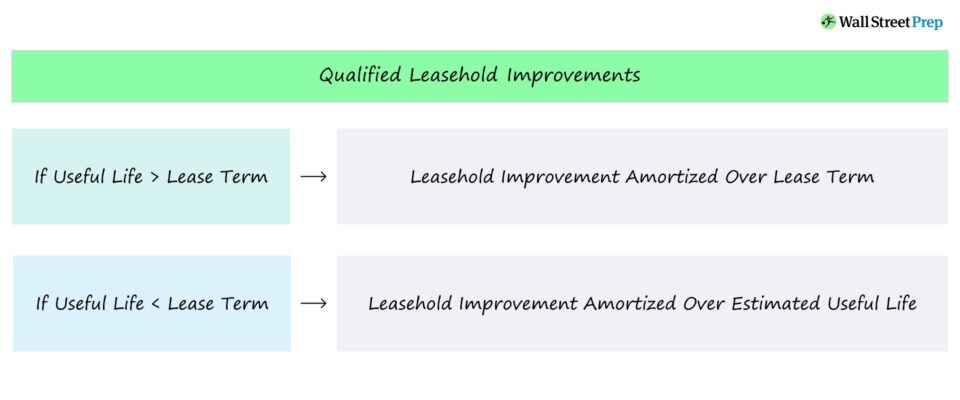- What are Lease Improvements?
- How Do Leasehold Improvements Work
- What are Examples of Leasehold Improvements?
- What is the Accounting Treatment of Leasehold Improvements?
- Are Leasehold Improvements Expensed or Capitalized?
- What is Considered Qualified Leasehold Improvements?
- What is an Example of Leasehold Improvement?
What are Lease Improvements?
Leasehold Improvements are expenditures that relate to the improvement of a leased property, which are amortized over either the lease term or the estimated useful life.

How Do Leasehold Improvements Work
A leased property can be altered by the tenant (lessee) or the property owner (lessor) in order to make it more suitable for fulfilling the tenant’s specific needs.
The costs of the leasehold improvements are paid by the tenant, who can use the improvements until the end of the lease agreement is reached. But once the lease expires, all the property – including the improvements made to date – would then belong to the landlord.
Notably, the approval of a tenant’s request for a leasehold improvement increases the property value, which directly affects a landlord’s ability to raise future rents.
Since the property becomes more functional post-alteration, the property becomes more marketable to current (and potential future) tenants.
Property improvements increase the odds of an existing tenant remaining in place for a longer duration, even if the price were to increase (i.e. pricing power) because a customized property establishes an incentive for tenants to extend their stay.
If the request for leasehold improvements is denied, however, the tenant could resort to moving to a different property, especially if the change is necessary for them to utilize the property fully.
What are Examples of Leasehold Improvements?
The most common examples of leasehold improvements include the following:
- Painting Walls
- Installation of Partitions
- Changing Flooring
- Display Shelves
- Plumbing Installation
- Carpeting and Tiles
- Lighting and Fixtures
- Security Equipment
- Office or Living Space Remodeling
The Wharton Online and Wall Street Prep Real Estate Investing & Analysis Certificate Program
Level up your real estate investing career. Enrollment is open for the Feb. 10 - Apr. 6 Wharton Certificate Program cohort.
Enroll TodayWhat is the Accounting Treatment of Leasehold Improvements?
To reiterate, leasehold improvements refer to alterations by a tenant to a rental property for the sake of customization.
The accounting rules that pertain to leasehold improvements are as follows.
- Capitalization → Once the improvements are confirmed, the cost is recognized as a long-term asset on the balance sheet. The total cost can include construction costs, architecture (and design) fees, permit fees, and more.
- Depreciation → The capitalized costs of the leasehold improvements are depreciated over the shorter of 1) the useful life of the improvements or 2) the remaining lease term. The accounting concept of depreciation is intended to allocate the cost of an asset across its useful life assumption, which is recorded as an expense on the income statement (i.e. “non-cash expense”).
- Impairment → If an unexpected event causes the fair value of the leasehold improvements to decline below their carrying value, an impairment loss is likely to be recognized on the books.
- Lease End or Early Termination → If the lease ends or is terminated earlier than originally scheduled, the remaining net book value (NBV) of the leasehold improvements – i.e. the original cost minus the accumulated depreciation to date – is written off as a loss.
Are Leasehold Improvements Expensed or Capitalized?
Our next section will address the question of, “How does the depreciation of leasehold improvements work?”
For purposes of accounting, the costs of leasehold improvements are capitalized as a fixed asset and then amortized rather than depreciated, as the prior section mentioned.
Once implemented, the improvements are owned by the landlord on paper, even if the one benefiting directly is the renter, i.e. the asset is an intangible “right” of ownership.
The improvements to leased properties are capitalized are then amortized over the shorter of the two:
- Estimated Useful Life of the Improvement
- Remaining Lease Term
The salvage value is assumed to be zero because ownership of the improvements returns to the lessor, not the lessee.
If the renewal of the lease (i.e. an extension by the tenant) is reasonably assured, the depreciation period can be covered to reach the end of the adjusted lease term (i.e. including any anticipated lease renewals), as long as the ending date is not beyond the useful life assumption.
While technically the cost is capitalized and amortized, it is acceptable to state it as “depreciation” as the difference in not meaningful. Conceptually, the two terms are intended for different types of assets (i.e. tangible vs. intangible) but are the same at their core.
What is Considered Qualified Leasehold Improvements?
Leasehold improvements are usually made to the interior of a property, such as the installation of new fixtures or the addition of equipment and furniture.
These sorts of modifications can occur in many commercial real estate locations, like offices, retail, and industrial spaces, mostly entailing changes to walls, ceilings, and flooring.
- Interior Walls
- Floor Finishing
- Ceiling Work
- Lighting Fixtures
- Restroom and Plumbing
- Carpentry (i.e. Internal Structural Changes)
Note: The repairs related to ordinary “wear-and-tear” are not treated as leasehold improvements.
What is an Example of Leasehold Improvement?
Suppose a tenant improved a leased office space immediately after moving in at the start of a ten-year lease.
If we assume that the qualified leasehold improvement costs a total of $200,000 and the useful life is estimated to be 40 years, the amortization expense is $20,000 per year.
- Amortization Expense = $200,000 ÷ 10 Years = $20,000
The lease term (10 years) is less than the useful life (40 years), so the amortization period used is 10 years instead of 40 years.






